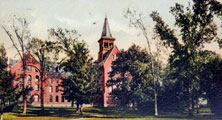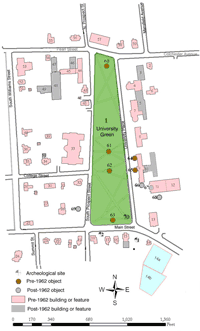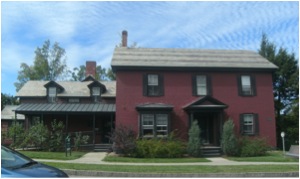 |
University Green Area Heritage StudyHistoric Burlington Research Project - HP 206Historic Preservation Program - University of Vermont |
Bittersweet House151 South Prospect Street
The current building located at 151 South Prospect Street is called the Bittersweet House. It is located on the southwest corner of the intersection of Main and South Prospect. It is an east-facing two-and-a-half story block. It has a three bay facade, with a one-bay entry porch in the center of the facade. The southern end of the house is a one-and-a-half story wooden recessed wing with a covered porch. The Bittersweet House has an extensive history ranging from an early 19th century convenience store to currently serving as the administrative offices for the interdisciplinary environmental programs at the University of Vermont. It has functioned in the Burlington community as a boarding house, a hub for university students and the home of a Burlington author and political figure. Most of all, it has been standing for over two-hundred years and continues to be a vital part of the University and greater Burlington area. According to the City of Burlington, Vermont Assessor's Property Database website, the building recognized as 153 South Prospect, also known as 151 South Prospect, was built in 1804.(1) According to David Blow in his book, Historic Guide to Burlington Neighborhoods, the building was built in 1809.(2) Regardless, it is safe to say it was built within the first decade of the nineteenth century. On a map of Burlington from 1869 it is identified as having been the property of Mrs. Wheeler, since the map also demonstrated that she owned a majority of the surrounding properties and buildings, it can be assumed that she rented them to others.(3) It is also recorded by Blow that the original building was built by the Tuttle family and was intended to be a general store.(4) The Burlington city directories identified W. L. Burnap, an attorney, as an individual resident in 1809.(5) Aside from him and a few other residents in the early nineteenth century, the majority of occupants were University of Vermont affiliated as students, professors, or Greek Life organizations.(6) In 1928 the building became the property of Mrs. W. Ramsay Smith, also known as Margaret L. H. Smith, and remained in her possession until 1961 when it became the property of the University of Vermont. During this period the building also served as a boarding house, a tea room, and a real estate agency.(7) Margaret Smith sold the building to the university in 1940, but retained a lifetime residency clause, and also a clause regarding the establishment and permanency of a bronze plaque identifying the building as the Bittersweet House.(8) Smith was a remarkable woman. Even though she was born in New York City, and educated in Massachusetts, her mother had a long family history in Burlington and she always considered herself a Vermonter.(9) In the early nineteenth century she married a Southerner, and lived on a small farm in Burlington which they called Bittersweet for two reasons: Bittersweet vines grew all over the property and in regards to the move to the North, her husband once said, "Maybe it will be bitter, maybe it will be sweet, depends on whether the Yankees like me or whether they don't."(10) The Bittersweet farm was dear to Smith, and she once wrote a detailed description about it in the opening of one of her books, Bittersweet Branches: "'Bittersweet' was an old new England farm house, and from its wide porches we looked westward to the Adirondacks and Lake Champlain, while on the East rose those beautiful hills- the Green Mountains of Vermont. Our doors were open to our friends from morning until midnight for my husband was a true southerner, and to him hospitality seemed vital. Our own animals roamed over our acres, while the wild, timid dear from the mountains ventured down to browse in the meadows along our brook, and the birds found sanctuary in our pine groves. It was a heavenly spot."(11) Her love for the farm clearly carried over to the house at 151 South Prospect when she moved there in 1928, as a widow, because a tragic car accident killed her husband in 1918.(12) Although such an event may have depressed lesser women, she only seemed to grow finer with age. When asked about being "extremely happy" even though she did not have any "near kin", she once replied, "Life has always seemed like a gorgeous rainbow of many colors...to me, these charming hues represent Birth-Love-Friendship-the pleasure of a full existence."(13) Her enduring outlook and exuberant personality allowed Smith's efforts as an author to flourish and her writings are currently a vital source to understanding the culture, history, and society of Burlington in her time. She left a legacy of intricate work and lived an outstanding life that it still characterized in the memories represented by the Bittersweet House. Her experiences and talents as an author, a business woman, a worldwide traveler, and a political force can be traced in the very books and poems she wrote and published. The books contain compilations of poetry and narratives written by Smith with insightful comments and honest intentions relating her experiences around the world to her humanistic nature and unwavering love for Burlington. Her efforts to bring peace and hope in times of conflict did not go unnoticed by the important people she surrounded herself with. Her efforts and the recognition of them by others are demonstrated throughout the series. She also wrote another book, one that she used to make Burlington famous worldwide, and earned her the friendships of international politicians which are represented in published letters from United Nations Representatives that sent tenderness and praise to Smith.(14) Smith provided an amazing contribution to Burlington's culture and greater historical story as a New England hub for activity, politics, and creativity. In 1946 The Burlington Free Press wrote "she has accomplished what many professional and literary men have struggled in vain to achieve. She has recreated the atmosphere of days long past. She has evoked emotions deeply felt years ago and still alive and moving today."(15) American delegator to the United Nations, Warren P. Allen wrote to her stating "Your allegory of Peace gives promise of unity. I know that your prayer, Great Lady, does, realistically and ideally, guide peoples of the United Nations towards peace."(16) Nothing can presently describe Smith any better than her contemporaries already have, and that within itself is evidence of a woman of Burlington that defied the masses. She is a leading example of a Vermonter crusading for peace at home and abroad, and she lived, worked, and inspired out of the building on the UVM Green known as the Bittersweet House. The Bittersweet House has substantial historical value in its nature as a boarding house, its proximity to the Green, and also simply the fact that it is over two centuries old, but when one considers the amazing life of the woman who lived, and some say still lives, there it takes on a whole new livelihood. Although the building is currently the center of UVM's interdisciplinary environmental program, a place where students can become familiar with a number of programs and experiences to further environmental studies, campus folklore maintains that Smith has never quite left the building. Upon first beginning research for this project, a simple Google search on the Bittersweet House at UVM returned countless stories regarding the ghost of a Mrs. Smith that still "haunts" the premises. Through all of the aforementioned stories and autobiographical information Smith has left behind, one can only imagine that if she remains in the Bittersweet House, it is not for reasons regarding unfinished business, or tragedy, or any other cliche reason most thrill seekers would use to explain a lingering spirit. It is in this researcher's opinion, that if Mrs. Smith remains, it is simply on the account of her undying love and devotion to Burlington. Perhaps her self-identification as a Vermonter and her cognizance of the Bittersweet House as a heavenly spot is what keeps her here, and for that, Bittersweet is all the more special. Text and image by Christine Prevolos, 2011 (1)Assessor’s Property Database for Burlington Vermont, (City of Burlington, VT: 2010) http://www.ci.burlington.vt.us/assessor/search/ (accesses October 27, 2011). (2)David J. Blow, Historic Guide to Burlington Neighborhood, (Burlington, VT: Chittenden County Historical Society, 1991), 173. (3)Frederick W. Beers, Plan of the City of Burlington and Town of South Burlington (New York: FW Beers, 1869). (4)Blow, 173. (5)L. P. Wait & Co., Burlington City (Vermont) Directory (Burlington: Free Press Printing Company, 1890), 87. (6)L. P. Wait & Co., Burlington City (Vermont) Directory (Newburgh, NY: L.P Wait & Co, 1913), 322./ H. A. Manning Company, Manning’s Burlington and Winooski (Vermont) Directory (Greenfield, MA: H.A. Manning Company 1916, 1917, 1918, 1922), 471, 375, 412, 436 (7)H. A. Manning Company, Manning’s Burlington and Winooski (Vermont) Directory (Springfield, MA: H.A. Manning Company), 1928-1961. (8)Blow,173. (9)Margaret L. H. Smith, Beautiful Burlington: Reminiscences and Impressions (Burlington, VT: The Author, 1948), xiii. (10)Blow,173. (11)Margaret L. H. Smith, Bittersweet Branches (Burlington, VT: Lane Press, 1946), ix. (12)Blow,173. (13)Margaret L. H. Smith, Bittersweet Berries (Burlington, VT: Smith, 1951), 3. (14)Margaret L. H. Smith, Beautiful Burlington: Reminiscences and Impressions (Burlington, VT: The Author, 1948), 58. (15)“Volume of Verse By Mrs. Smith Appearing Today”, The Burlington Free Press, November 18, 1946. (this was a clipping within a book, there was no author) (16)Margaret L. H. Smith, Bittersweet Blessings (Burlington, VT: s.n., 1952), 3
|

